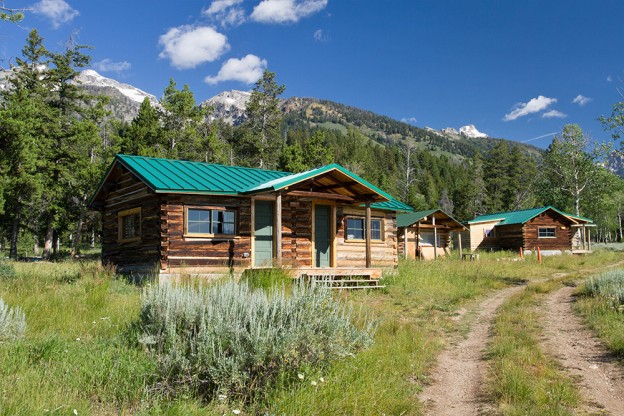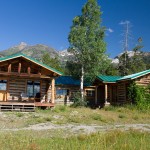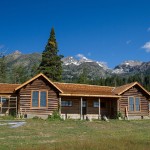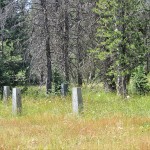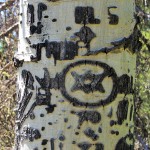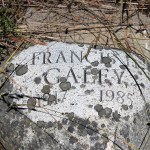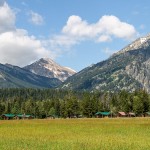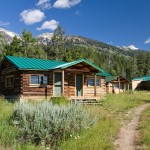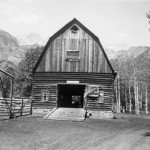- Hammond Cabin at White Grass Dude Ranch. Photo by Samantha Ford
- Main Cabin at White Grass Dude Ranch. Photo by Samantha Ford
- White Grass Ranch Cemetery. Photo by Samantha Ford
- Carvings in tree at the White Grass Cemetery. Photo by Samantha Ford
- Frank Galey grave at the White Grass Cemetery. Photo by Samantha Ford
- White Grass Dude Ranch. Photo by Samantha Ford
- Sleeping cabins at White Grass Dude Ranch. Photo by Samantha Ford
- Main Cabin at White Grass Dude Ranch. Collection of Jackson Hole Historical Society and Museum.
- White Grass Dude Ranch barn. Collection of the Jackson Hole Historical Society and Museum
To learn more about the White Grass Ranch, visit www.whitegrass.org – a website completely dedicated to this spectacular ranch in partnership with the Jackson Hole Historical Society and Museum and the White Grass Heritage Project.
—
Harold Hammond was born in Idaho and came to Jackson Hole as a child in the early 1900s. From 1910-1911 he worked as a wrangler for the Reclamation Service in Moran. He remained here until the completion of the Jackson Lake Dam and found work at the Bar BC Ranch. During his time there it is assumed that he met Tucker Bispham, who was visiting for the summer as a dude. Bispham was from a wealthy family in Pennsylvania, and found his way west with several of his family members and friends.
Harold and Bispham created a partnership and settled on adjacent 160-acre parcels of land in 1913. They both applied and received patents for their land. Bispham watched over Hammond’s ranch while he was away during World War I. Their intent was to open a dude ranch much like the Bar BC, and by 1919 they could host 10 people in three cabins and a sleeping tent. A few years later in 1923, they entered into a larger partnership with the Bar BC Ranch to open a summer camp for boys. The camp charged $900.00 to teach boys the “simple life of traditional skills.” They were joined by Struthers Burt, Horace Carncross, Irving Corse and Sinclair Armstrong. Both Hammond and Armstrong would sign on as directors of the summer camp. This partnership operated three ranches. The Upper and Lower Bar BC, as well as the White Grass Ranch for Boys. Parents wishing to visit their sons were encouraged to stay at the nearby Upper Bar BC Ranch. Unfortunately the summer camp didn’t seem to be popular as families preferred to remain together and the partnership was dissolved only 5 years later.
During the years of the summer camp, Hammond saw an opportunity to make more money on his ranch to help supplement rising costs. In 1925 he purchased 6 breeding pairs of silver foxes. Their fur was in high demand among the wealthy, and he intended to create a small fox farm on the ranch. This farm was successful and Hammond credited it with helping him to survive the Depression. When the ranch transferred hands to new owners, the fox operation continued. The pens are no longer extant, but they were located northwest of the main cabin cluster.
In 1928 Hammond and Bispham left the Bar BC Partnership and their properties were deeded back to them. At this time, Hammond purchased Bispham’s 160 acres to create a unified 320-acre White Grass Ranch. Hammond now had over 15 log cabins and could sleep up to 30 dudes. With the aid of his silver fox furs he could ride through the Depression relatively unscathed. He did, however, take out mortgages to finance a few ambitious building projects. He used the money to construct a bathhouse with showers, toilets and a laundry facility, as well as private bathroom additions to the sleeping cabins. He also expanded his personal house at the time, putting an addition on the north side of the main cabin.
Hammond and his first wife, Marie ran the ranch until her death in 1935. Just a year later in 1936, Hammond married the woman who had helped him care for his ill wife. Marian Galey and her son Frank moved to the ranch that summer. Frank initially only stayed for the summers, returning to his studies in Princeton in the fall. He and his mother had originally come to the valley to vacation at the Bar BC Ranch, where it is assumed Marian met Hammond. It was a short marriage, as Hammond died in 1939 after only three years. His step-son Frank Galey left school at Princeton to join his mother in Jackson Hole to run the White Grass year-round.
The Galeys would be absent from the property for several years during World War II. At this time the ranch was all but closed, and hosted no formal guests. Several caretakers would be hired to maintain the buildings and the fields, and some dudes who visited annually helped take on some of the work. Despite their efforts, the property fell into disrepair. After a 5 year absence, Frank Galey returned to the ranch with his wife Ingeborg Freitag Galey and their young daughter, Cynthia. They found the cabins in much need, and due to the war shortages had to make due with mediocre repairs.
For the next decade Frank and Inge ran the ranch and repaired the cabins. By 1956 they could host 55 dudes, with some staying for up to two months at a time. The White Grass Ranch had a strong set of annual visitors, families and individual dudes alike. Soon the cabins became named for the families that rented them year after year. The names often changed, as families grew older and ceased their annual visits. The male and female staff were housed in separate cabins and both made use of the central bathhouse. The sleeping cabins all had wooden frame bathroom additions, an update made under the Galeys’ tenure. Other updates the Galey family made were a new log house for their personal use and a swimming and fishing pond that Frank named Lake Ingeborg.
Frank Galey, in addition to continuing the fox farm, also kept up with the haying and cattle raising. They usually kept 5-6 pairs of Herefords, as well as 2-3 milking cows, pigs and chickens. They also housed work horses for haying and had about 50 saddle horses for the dudes. The livestock would be slaughtered each fall, and the horses were wintered in Lander, WY. By the mid-1950s electricity would make its way to the ranch, adding more modern comforts that were increasingly being sought after by the new waves of dudes. Some dudes dug ditches to run into small dammed puddles to store their drinks to keep them cold. These ditches are still visible on the landscape today.
In 1953 Frank Galey was approached by a man named William Balderston II who had fallen in love with the valley and desperately wanted to own land. Galey conceded and sold Balderston 13 acres on the northern end of the White Grass Ranch. Balderston built a small private family retreat and named it the Sky Ranch. He made an agreement with Galey that he would only use it for family purposes and not compete with the White Grass for business. He kept his promise, and only used it for family purposes.
In 1956 the Galeys sold the majority of the property to the National Park Service under a life estate lease, keeping their personal cabin and 6 acres. This year would mark the last winter they spent at the ranch. The cattle and farming operations stopped, and there were no human inhabitants on the ranch during the winter months. In the summer they kept the fields irrigated to allow the horses to have access to good forage. With the extra cash garnered from the sale, the Galeys purchased a small resort on the Island of Nevis in the West Indies. For a short time, Frank and Inge wintered there and spent their summers at the White Grass Ranch. They were required by the lease to maintain the buildings and keep the ranch in good working order. Any improvements or changes beyond annual work had to be approved by the Superintendent’s office. They did add a deck to the south side of their cabin, and moved a couple cabins to the ranch from Cooke City, MT.
By 1970, Frank and Inge were divorced and Frank married his second wife, Nona. They would run the ranch in the summer months for the next 13 years. 1970 was a pivotal year for the White Grass as well. Prior to 1970, dudes stayed 2-3 weeks at a time, and participated in week-long pack and fishing trips. The idea was to be immersed into the western lifestyle and remain for a long period of time. Most dude ranches required a minimum stay of 2 weeks. Some dudes stayed up to 2 months. The idea was to leave the family car at home and allow efficient and comfortable rail service to take you to your destination. However, automobile travel was quick and easy thanks to improved interstate road systems. These allowed the occupants to see several places on a single trip, rather than traveling out to one destination and essentially being stranded there. After 1970, the average stay was 3 nights to two weeks, with a 1-2 hour ride, or an afternoon fishing trip. As a result, the Galeys began to house more people in a single cabin and began to defer maintenance on the buildings.
In 1983 Frank sold the remaining 6 acres to the National Park Service and retained a life estate for his wife Nona. He must have been aware of his failing health because only three years later in 1985, he died. That same year, Nona auctioned off all of the interior cabin furnishings, the remaining livestock and farming equipment. She kept her cabin and her own personal belongings, but knew the ranch was too much to take on herself. Many of the bidders at the auction were former employees and dudes who had strong connections to the ranch. Only a month after the auction disaster struck when her personal cabin burned to the ground. She lived in another cabin briefly, but this would be her last summer at the ranch.
After Nona’s departure in 1985 the National Park Service completed an inventory of all of the man-made structures on the property and began to dismantle them. Their intent was to return the property back to its natural setting. They removed all of the irrigation systems, fencing and the pond. They also sold a few cabins as well as the barn, and had them removed from the property. Before they could go much further, however, shifting ideas about historic preservation and a well-timed listing in the National Register of Historic Places in 1990 stopped the removal of the remaining cabins. In 2000 and 2003, the buildings were evaluated for stabilization and rehabilitation. The Western Center for Historic Preservation was created and claimed the White Grass as its official training facility. Over the last decade the ranch has been systematically restored to serve a growing need for preservation projects. The ranch houses several groups for training seminars with participants spanning from Alaska to Arizona. The preservation work has been on-going and is slated to be finished in 2016.
TIMELINE
1913: Harold Hammond files for a 160-acre homestead on the west side of the Snake River, north of the JY Ranch. He builds the first structure on his property, a 28’x48’ log house.
1915: Hammond plows and plants 16 acres of oats for grain. Meanwhile, Tucker Bispham who is residing on an adjacent claim cultivates 10 acres of barley.
1916: Hammond increases the 16 acres of oats to 40 acres, and includes barley. Bispham clears and plants 15 acres.
1917: 56 acres are now growing oats and barley.
1917-1919: Harold Hammond enlists and fights in WWI. Bispham clears and plants 20 acres, in addition to watching over Hammond’s claim as well.
1918: Hammond claims 80 acres are now being cultivated. This is probably thanks to Bispham, who remained on the properties while Hammond was away.
1919: The White Grass ranch hosts its first paying guests. It could sleep 10 dudes, between three cabins and a sleeping tent, most likely on Bispham’s property.
1920: Hammond receives the patent for his property. He adds more structures, including a barn, storehouse, bunkhouse and corrals for horses and cattle. Bispham clears and grows 45 acres of alfalfa.
1921: Tucker Bispham files a claim for a 160-acre homestead adjacent to Harold Hammond. He states in his application that he began improvements in 1915. This is also the first documented winter that he spends at the ranch.
1923: Tucker Bispham receives the patent for his property. Both men operated under the same name of White Grass and used the same cattle brand (H quarter circle B), despite owning their parcels individually.
1923: Hammond and Bispham deed their ranch to Bar BC Ranches, Inc. They form a partnership consisting of Harold Hammond, Tucker Bispham, Struthers Burt, Horace Carncross, Irving Corse and Sinclair Armstrong. The White Grass Ranch becomes The White Grass Ranch for Boys and operates as a summer camp in connection with the Bar BC. Hammond and Armstrong were the directors of the camp.
1925: It is unlikely that the White Grass Ranch for Boys ever operated at capacity. Hammond likely turned to other pursuits to supplement this income. He imports 6 breeding pairs of silver foxes, and begins a small farming operation for their furs. Hammond would later claim that his fox farming would allow him to survive the Depression.
1928: Hammond and Bispham withdraw from the partnership, and they are deeded back their respective properties. Bispham then sells his lot to Hammond, creating a united 320-acre White Grass Ranch.
1928-1935: Hammond and his first wife, Marie Ireland Hammond jointly operate the ranch. By 1930, they have 15 log cabins on their property.
1935: Marie Hammond dies.
1936: Harold Hammond marries his second wife, Marion Galey.
1936-1939: Hammond and Marion Galey operate the ranch. Hammond raised 50 cattle, as well as cultivating many acres of hay for winter feed. He constructed a bathhouse with showers, toilets and laundry facilities. He would also add wood frame bathroom additions to the sleeping cabins.
1939: Harold Hammond dies.
1939: Hammond’s step-son, Frank Galey moves to the ranch full time to help his mother with
operations. He had initially come to the valley and stayed at the Bar BC Ranch and moved to White Grass when his mother married Harold Hammond.
1941-1945: Galey enlisted and fought in the war. During this time, the Galeys hired caretakers to keep the ranch in working order. Most operations ceased during this time and a few dudes who were summer regulars made trips to help with some of the maintenance work.
1946: Frank Galey returns to the White Grass Ranch with his wife, Ingeborg Freitag Galey and their daughter Cynthia. They returned to run down cabins in need of many repairs. Due to the war shortages, they patched up the problem areas as best as they could.
1946-1956: The Galeys ran the ranch, making some improvements. They added wooden frame bathrooms to the cabins, and constructed a new log house for the family in 1949. Galey also built a swimming and fishing pond that he named Lake Ingeborg. He also continued to cultivate timothy and alfalfa hay for a small cattle operation. They kept about 5-6 Hereford cows, 2-3 milk cows, work horses, saddle horses (which were trucked to Lander in the winter), hogs and chickens. The fox farm also continued under the Galeys. In 1946 they housed 30 dudes, some staying for up to two months. By 1956, they could house 55 dudes and added electricity to the ranch buildings.
1953: Galey sold 13 acres of land to William Balderston II. Balderston built a small, private summer retreat for his family. He called it the Sky Ranch.
1956: Frank and Inge sold their ranch to the Grand Teton National Park, with a life estate lease allowing them to remain on the ranch, and continue operations. They kept 6 acres around their house, but sold the rest. They were required to maintain the structures and allowed to make minor changes to keep the buildings in working order. Any major projects or additions had to be approved by the Superintendent’s office. The Galeys no longer wintered at the ranch, or raised cattle. The Balderston acres were not included in this sale.
1956-1970: The Galeys continue to run the ranch, wintering in the West Indies on a small resort they purchased with the money from the White Grass sale. By 1970, they were divorced and Frank married his second wife, Nona. They continue to run the ranch together.
1985: Frank Galey dies.
1986: Nona Galey auctions off all of the furnishings and interior belongings from the ranch cabins. Many former employees and dudes are present as bidders. The auction even included remaining livestock and farming equipment. Nora kept her personal cabin, the furnishings and personal belongings inside it.
1986-1990: The NPS wanted to return the ranch to its natural setting and began removing various parts of the infrastructure. The barn and some cabins were sold and moved off the property. Virtually all the fencing, irrigation system and pond were removed.
1990-2005: Park policy on historic preservation began to shift towards preservation of the built environment, buildings began to be re-evaluated for stabilization and rehabilitation across the park. At White Grass, bracing and stabilization measures were installed so that a formal plan could be drawn up in the near future.
2005: The Western Center for Historic Preservation is created to create an adaptive reuse of the White Grass Ranch as a training center for preservation practices and techniques.
2016: The restoration and preservation work at White Grass is slated to be finished in connection with the 100-year anniversary of the National Park Service. The ranch will now serve as a national training facility for historic preservation.
Text by Samantha Ford, Director of Historical Research and Outreach



